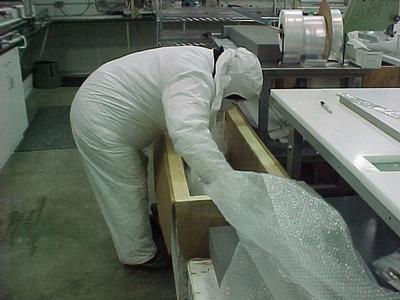18 June, 2001
Monday, June 18th
Today I met some other members of the research team in Denver,
Colorado at the National Ice Core Laboratory. Dan Dixon, Susan, and I
spent most of the day processing the ice cores form the 2000-2001 U.S.
ITASE (International Trans-Antarctic Scientific Expedition) traverse. We
worked in a refrigerated room at -24* C (-11* F) to slice and package the
cores for shipment to various research labs around the U.S. Because the
room is so cold, we have to wear very warm protective outer clothing. We
also wear thin, white "clean suits" to reduce the contamination of our
clothes to the cores (see pictures).
Susan was at the start of the assembly line, and she used an electric saw
to slice each 1-meter length of core lengthwise. The core was then slid
to me and I took one of the slabs and put it in a plastic bag. I wrote
the sample number and the depth from which the core was drilled on the bag
and placed it in a shipping container.
I slid the remaining core slab on to the next person, who shaved off the
uneven edges made by the saw and sent the core through a machine that
measures the electrical conductivity of the core from top to bottom.
Electrical conductivity measures how easy it is to send electricity
through the ice. The resulting graph will help the scientists match the
layers of this core to layers from other cores that were drilled along the
traverse. The core is then sent on to a station where it is examined for
individual layers, which are recorded in a logbook. Finally, the core is
sliced once again and packaged for shipment to other labs.
Gordon Hamilton arrived in the afternoon and we started to cut his cores
into 20-cm lengths. We put each sample into a Ziploc bag and labeled it
with a number for record keeping. The ice will melt, and the water will
then be analyzed for strontium. A high level of strontium in a sample
indicates that the snow fell during the same years as the nuclear-bomb
testing in the Pacific, 1955 and 1965. This information will allow Gordon
to date that layer and eventually figure out how much snowfall has
occurred each year since then by measuring the thickness of the remaining
layers of ice.

Jan loading cores into shipping box.

Preparing the ice core for cutting <>
Contact the TEA in the field at
.
If you cannot connect through your browser, copy the
TEA's e-mail address in the "To:" line of
your favorite e-mail package.
|
